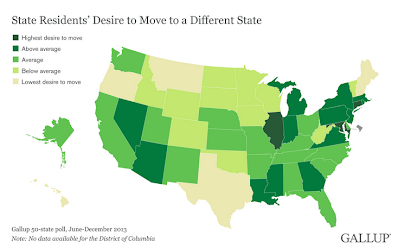According to new data from Gallup, a significant percentage of people in Illinois and Connecticut expressed a desire to leave their states if given the chance. Approximately 50% of Illinois residents and 49% of Connecticut residents indicated a wish to move. Additionally, a notable portion of the northeastern seaboard population also expressed a willingness to relocate.
On the other hand, residents of Montana, Hawaii, and Maine were found to be the least likely to consider leaving their states, with less than one-quarter of them expressing a desire to move. Overall, around 33% of Americans surveyed said they would leave their current states if given the opportunity.
In certain states, such as Illinois, Maryland, and Connecticut, around 40% or more of the population expressed a desire to move. However, despite these intentions, the actual percentage of people who end up moving is much lower, with only about 6% of respondents stating they were very or extremely likely to change states in the next year.
The decline in interstate migration has been significant over the past two decades, with the gross interstate migration rate dropping by roughly half, from almost 3% to around 1.5%, between 1990 and 2011. This decrease in mobility may have negative implications for the economy, as it can lead to fewer job opportunities and hinder economic growth.
The reasons for people wanting to leave their states varied, with work or business-related factors being the most common. States such as New York, Illinois, and Maryland cited taxes as a key reason, while New York and Connecticut residents were more likely to mention a high cost of living.
There are multiple factors contributing to the decline in interstate migration. The rise of a more homogeneous US economy and the prevalence of online information makes it easier for individuals to find similar job opportunities across different cities. This, combined with a shift from goods-producing jobs to services jobs, has reduced the need for geographic-specific employment.

